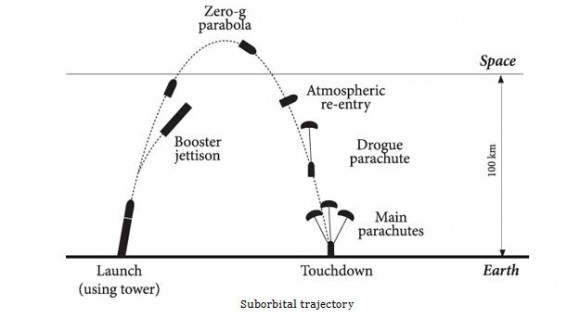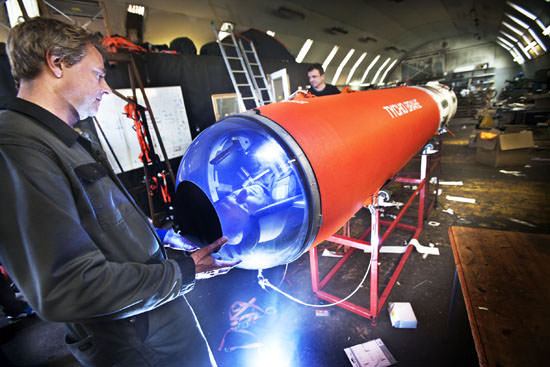[/caption]
Copenhagen Suborbitals hopes to launch the world’s first amateur-built rocket for human space travel and have announced an upcoming launch window for their Tycho Brahe capsule. The window extends from June 1-14, 2011 and they are currently shooting for Thursday, June 2 for an unmanned suborbital test flight, according the their website. The group is headed by Kristian von Bengtson and Peter Madsen, and their HEAT 1-X rocket is being prepared for launch from a steel catamaran in the Baltic Sea off the coast of Denmark.
If all goes well with this test flight, Madsen hopes to be inside the capsule himself for a manned flight in the near future.
The company, which is funded by donations, is working towards launching tourists on suborbital flights in the single-seat capsule to altitudes above 100 kilometers (62.5 miles).
And talk about a wild ride : the Tycho Brahe capsule will provide a single passenger capsule with a full view through a polymer plexiglas-dome so that the person can see and experience the entire ballistic ride. It has a pressurized volume providing support for one upright standing/half-sitting person. It will also have additional pressurized space, around and behind the astronaut, available for several other systems necessary for the flight procedure, and to support additional scientific and commercial project.

No specific launch time has been announced, so check their website for more updated information. There will also be live coverage and launch parties in Denmark.
Check these links for possible online coverage:
Live internet coverage: www.ing.dk/live
and http://maylaunch.dotsquare.dk/
Copenhagen Suborbitals were hoping to launch their first test flight last summer, but ran into problems with their rocket.


I’ve always said I’d jump at any opportunity to go to space, anytime, any place, anyhow, but no. Hell no.
Under the pic it says “dummy is loaded”. Who was the ‘dummy’ ;o)
Ils sont fous ces Danois.
Ils sont fous ces Danois.
Whenever I read about Copenhagen Suborbital I never know whether to think they are crazy or brilliant.
Whenever I read about Copenhagen Suborbital I never know whether to think they are crazy or brilliant.
Hah. My thoughts exactly.
Guess we’ll find out soon enough.
Spam in a can
i would do it for free!
Does it come in an XX-Large for larger passengers? lol
Haha, “Von Bengtson”. That name is impossible 🙂
Google it. Lots of von Bengtson. As a swede I find it one of the least impossible (spelling, pronunciation) danish names.
Pocket rockets anyone?
Damn – that would be terrifyingly awesome.
Simply too cool. Talk about minimalistic design. Why not?
It’s not clear how the parachutes work though. It looks like the passenger is descending feet down, though of course he’s missing all the view. Head down would be better, but best of all would be if they can hang it by the waist, so the passenger is looking at the horizon while under parachute, and change to feet down just before touchdown. What a ride.
The most minimalistic design competing with SS1 on the Ansari X Prize was bundling together solid rockets and saddling a man with a space suit and a chute behind a wind shield. They could test that in a more staged project too.
The difference being, with the lack of launch escape system, that if any one of the many candles burst the result went directly to your crotch. :-/
[Not saying that some of the future suborbitals won’t lack the usual LES. But at least the SS2 will have a winged return path in case of engine out.]
Visibility and g’s:
– Assuming the shown design is close to the intended manned, it will have fair visibility since the dome is larger than a head. Hanging passively from a chute mean your body tend to hide some of the scenery anyway. (Which is one reason you want the swoop ability with a maneuvered winged chute in a normal jump.)
But the dome also means the chute will be situated further down the rocket body, below your feet. You will get some of your visibility angle, better than a passive drop.
– Some of the g forces, which in suborbitals are not much lower than orbitals (IIRC ~ 3 – 4 g instead of 4-5 g), can be dealt with by a harness taking the body weight. But yes, without bent legs the hearth will surely have more to handle than with a seated person.
ooh… I like that… well, at least the guts and glory. 🙂
What I think will happen is that by the time you account for the space suit and the structural support for the rocket, you won’t be too far off from the weight of this here capsule – their cylinder is the lightest possible pressure vessel.
I don’t know how their parachute works. With some suborbital flights, like the first Freedom 7 shot, loads were probably intentionally high, since they were getting ready for orbital flights. Also, not all suborbital trajectories are the same. Technically, a ballistic missile is suborbital, but it reached almost orbital speeds.
From what little I know, in principal, if you only go to 100 km and are ok with light flimsy structures, you try to aerobrake asap, which might also get you out of various stability issues associated with high-speed reentry. (like SS1/SS2 is doing)
Falling from 100 km to say 30 km where you start to get any kind of traction is still pretty fast – my calculator says 1.2 km/sec – anything you can shave off of that is good. I’d calculate terminal velocity with a small drogue chute, but the day is growing short, so gtg…
Oh yeah – if they can make the dome deep enough that even with a protective helmet your eyeballs are above the seam line (so you can look “downish”) then I’m fine with feet-down all the way.
Head’s down attitude at how many Gee’s?
I’m talking about the parachute stage – would you rather be hanging there looking at a canopy, at the big blue , or at the horizon?
The aerobraking will be feet-down, no question about that…
There is a reason most spacecraft have the crew seated the way they do, it’s called Gee forces. What good would a flight on this rocket be if you were out cold? A standing position will flood the lower extremities with blood at high Gee during launch. Better wear a Gee suit? Conversely, a parachute below your feet has the capsule in a heads down attitude when deployed with your blood flooding your brain. And there is the distinct possibility that a cylindrical shape might spin or tumble during the descent, or do both prior to parachute deployment – all at an unknown rate – jet stream dependent?
Well, if you want to get technical….
a) this is not “most spacecraft” – it is suborbital. Much less speed. Maybe even more acceleration on ascent than on descent.
b) It’s doing a ballistic re-entry, not a lifting one, so there’s no question it’s coming down initially feet first.
c) I don’t know when it deploys the chute, but I’m guessing that they are going “as soon as possible, but no sooner” – which means you have plenty of “hang time”. Under parachute, you’re hardly decelerating.
d) Thus, just for kicks, I’d rather have the rocket hang in an orientation that allows me to get a good view… So I’d harness the chute from the waist of the rocket, very slightly in front of the C.G.
a) Being suborbital, it will probably be a steeper entry, and possibly quite high deceleration. Look at, for instance, how much deceleration Shepard saw with Freedom 7.
b) Complete non-sequitur. It only depends on what orientation the vehicle is stable in.
c) I sure as hell wouldn’t want to be heads-down under chute. Even if it is just 1 g, that would still suck after a few minutes.
a) I’m curious – how high did he go, what speed did he reach on the way down, and what deceleration? Maybe wiki has the answers.
b) Hardly – the capsule is built to be pushed from below, and has a plexiglass front dome… It will be designed to reenter feet first, for both its benefit and the pilot’s.
c) For the parachute descent, I’m talking about wanting it to hang horizontal, with perhaps a slight upward angle – from a passenger’s point of view, at least for me, this seems more fun that looking straight up into a canopy. Before touch-down though, it should go back to feet-first, and there are a few things you can do with the harness to achieve that.
hmm… wikipedia doesn’t give specifics, but it does put the s/c mass at 1200 kg. Probably dry. So with pilot and extras, maybe 1500 kg? And it says the drogue opens at 21,000′
If it’s that low with this capsule too, then I wouldn’t bother with any of the above, since the pay-off is not worth it. If they can open it higher (since it’s a lighter capsule) then maybe.
Either way, I like the head-out configuration. A plexi-dome like this is better than a flat window.
b) Not going to argue about how it will be/should be designed, just that the fact that it’s ballistic does not determine its orientation. Ballistic only indicates that there’s no appreciable lift vector.
Maybe i missed it in the news or the morning shows, but this seems to be largely unnoticed in denmark? There will probably just be a mention of it with a short clip in the news when it HAS happened.. That would be typical of danish media!
A dane.
Last year there was live transmission for a couple of hours on DR I believe… so there will be coverage on the day for sure.
It’s most likely to happen on friday.
Oh i missed that! I will certainly try not to miss it this time around then. A pleasant surprise actually, i thought the media would be too focused on political stuff as they usually are.
Where’s Andy Griffith and Salvage One?
I wonder if they have room to scratch their nose once inside… That would be so irritating.
Wonderful, Ingenious. God Speed!
Wonderful. God Speed! I couldn’t afford a ride but after 9 or 10 sucesses I’d think about it if I could afford it.
I can just see the final design board…
“We need a final design on this ASAP…get on it!”
“Oh just shove it up your…”
“Brilliant idea! Get me the prints by Monday”
Seriously…that is one rocket you’d never convince me to get on. I don’t care where it’s going to take me. Someone else can be a human ICBM.